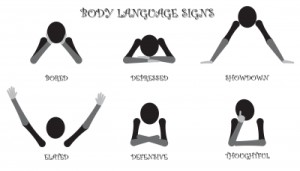Yes, that’s true. Without saying a word, you can communicate volumes of information to the interviewer. You communicate by facial expressions, posture and movement. A savvy interviewer can decode you actions. If they don’t like what they see, you are out. Your skills and experience on your résumé got you an interview. Your body language shows if you are a “good fit” with the rest of the team.
What should you be aware of? Here is a list:
1. Arms—don’t cross them in front of you. It is a defensive gesture. Nor should you be waving them around when you are speaking.
2. Hands—keep them away from your face. Touching your face indicates anxiety or lying.
Keep your hands and arms close by you but visible to the interviewer. If you gesture when you talk, do so without using large movements. Shake hands with a firm grip somewhere between bone crushing and a weak, dead fish handshake. Don’t play with anything in your hands such as a pen or twirl your hair.
3. Eyes—make eye contact without staring. Glancing around the room without making eye contact indicates boredom or lying. Try looking at the area between the interviewer’s eyebrows or chin.
4. Facial expressions—keep your face soft with a warm, genuine smile instead of tense. Avoid frowns and smirks.
The interviewer looks at your face for most of the interview. A friendly expression that shows confidence and interest is more appealing that an expression that shows anxiety, desperation or dishonesty.
5. Sit squarely in the chair—don’t lean to the side or slouch. Leaning back in the chair shows arrogance. Instead, sit up straight and lean in slightly, it shows interest in what the interviewer is saying.
6. Feet—keep your feet on the floor. Don’t cross your legs or put your ankle on your knee both gestures indicate complacency.
Your posture in a chair or standing should show confidence, interest and truthfulness. Walk upright your head held high, and your shoulders back, you look professional, confident and competent. All the right messages that you are the one they are looking for.
If you aren’t sure what your non-verbal presentation looks like, videotape a mock interview and review it with another to find where your body language needs attention. After you know what needs to be changed, practice interviewing and be aware of your actions and appearance.
Your body language alone won’t get you the job. You are a complete package. Your skills, experience, accomplishments, along with your answers and demeanor are all essential. Prepare your verbal and nonverbal communications to ace the interview.



Good points, and let me add an additional one: be sensitive to cultural differences. For example, in some cultures, direct eye contact may be considered rude, and some hand gestures, while acceptable in some cultures, may be offensive in another. In a culturally diverse workforce we need to aware and sensitive to these differences.
Good point Pat! Thank you for reminding us to be culturally sensitive. Very important point.
This was helpful, Arleen — thank you. I’ve heard most of your suggestions before, but what I especially liked was that you told WHY certain positions are detrimental to the interviewer’s perception of you.
Even though we know these tips, sometimes they don’t mean anything until you have the WHY. Then it all comes together. Thank you for pointing that out.
Hi Arleen,
Great article. Nice length. Helpful information. AND easy to leave a comment. Thanks. I passed your blog on to a couple others.
Thank you Pam! You are the best!